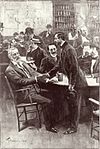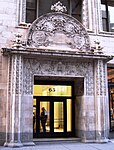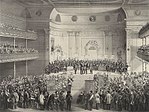Canterbury Hall (New York City)
Broadway (Manhattan)Buildings and structures demolished in 1861Burned buildings and structures in the United StatesCultural history of New York CityDemolished buildings and structures in Manhattan ... and 3 more
Event venues in ManhattanLower ManhattanManhattan building and structure stubs
Canterbury Hall was an edifice located at 663 Broadway in the 19th century. It was used for entertainment and political meetings. It was a three-story building where bawdy concerts took place. The building had a front of 40 feet and a depth of 125 feet.
Excerpt from the Wikipedia article Canterbury Hall (New York City) (License: CC BY-SA 3.0, Authors).Canterbury Hall (New York City)
Washington Square North, New York Manhattan
Geographical coordinates (GPS) Address Nearby Places Show on map
Geographical coordinates (GPS)
| Latitude | Longitude |
|---|---|
| N 40.727 ° | E -73.995666666667 ° |
Address
New York University
Washington Square North
10012 New York, Manhattan
New York, United States
Open on Google Maps









